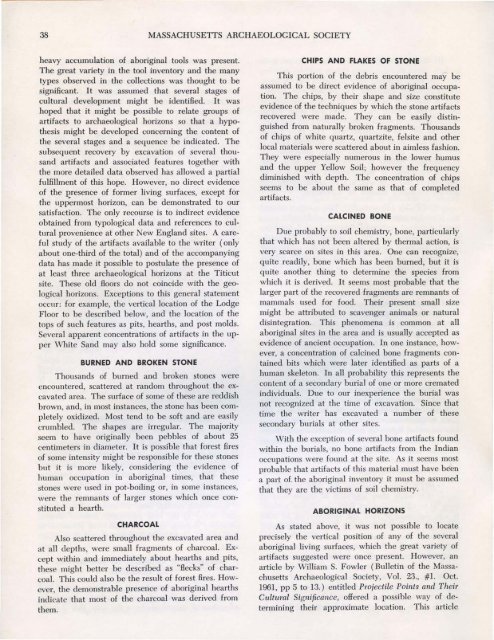Titicut Site
Titicut Site
Titicut Site
Create successful ePaper yourself
Turn your PDF publications into a flip-book with our unique Google optimized e-Paper software.
38 MASSACHUSETTS ARCHAEOLOGICAL SOCIETY<br />
heavy accumulation of aboriginal tools was present.<br />
The great variety in the tool inventory and the many<br />
types observed in the collections was thought to be<br />
significant. It was assumed that several stages of<br />
cultural development might be identified. It was<br />
hoped that it might be possible to relate groups of<br />
artifacts to archaeological horizons so that a hypothesis<br />
might be developed concerning the content of<br />
the several stages and a sequence be indicated. The<br />
subsequent recovery by excavation of several thousand<br />
artifacts and associated features together with<br />
the more detailed data observed has allowed a partial<br />
fulfillment of this hope. However, no direct evidence<br />
of the wesence of former living surfaces, except for<br />
the uppermost horizon, can be demonstrated to our<br />
satisfaction. The only recourse is to indirect evidence<br />
obtained from typological data and references to cultural<br />
provenience at other New England sites. A careful<br />
study of the artifacts available to the writer (only<br />
about one-third of the total) and of the accompanying<br />
data has made it possible to postulate the presence of<br />
at least three archaeological horizons at the <strong>Titicut</strong><br />
site. These old floors do not coincide with the geological<br />
horizons. Exceptions to this general statement<br />
occur: for example, the vertical location of the Lodge<br />
Floor to be described below, and the location of the<br />
tops of such features as pits, hearths, and post molds.<br />
Several apparent concentrations of artifacts in the upper<br />
W'hite Sand may also hold some significance.<br />
BURNED AND BROKEN STONE<br />
Thousands of burned and broken stones were<br />
encountered, scattered at random throughout the excavated<br />
area. The surface of some of these are reddish<br />
brown, and, in most instances, the stone has been completely<br />
oxidized. Most tend to be soft and are easily<br />
crumbled. The shapes are irregular. The majority<br />
seem to have originally been pebbles of about 25<br />
centimeters in diameter. It is possible that forest fires<br />
of some intensity might be responsible for these stones<br />
but it is more likely, considering the evidence of<br />
human occupation in aboriginal times, that these<br />
stones were used in pot-boiling or, in some instances,<br />
were the remnants of larger stones which once constituted<br />
a hearth.<br />
CHARCOAL<br />
Also scattered throughout the excavated area and<br />
at all depths, were small fragments of charcoal. Except<br />
within and immediately about hearths and pits,<br />
these might better be described as "flecks" of charcoal.<br />
This could also be the result of forest fires. However,<br />
the demonstrable presence of aboriginal hearths<br />
indicate that most of the charcoal was derived from<br />
them.<br />
CHIPS AND FLAKES OF STONE<br />
This portion of the debris encountered may be<br />
assumed to be direct evidence of aboriginal occupation.<br />
The chips, by their shape and size constitute<br />
evidence of the techniques by which the stone artifacts<br />
recovered were made. They can be easily distinguished<br />
from naturally broken fragments. Thousands<br />
of chips of white quartz, quartzite, felsite and other<br />
local materials were scattered about in aimless fashion.<br />
They were especially numerous in the lower humus<br />
and the upper Yellow Soil; however the frequency<br />
diminished with depth. The concentration of chips<br />
seems to be about the same as that of completed<br />
artifacts.<br />
CALCINED BONE<br />
Due probably to soil chemistry, bone, particularly<br />
that which has not been altered by thermal action, is<br />
very scarce on sites in this area. One can recognize,<br />
quite readily, bone which has been burned, but it is<br />
quite another thing to determine the species from<br />
which it is derived. It seems most probable that the<br />
larger part of the recovered fragments are remnants of<br />
mammals used for food. Their present small size<br />
might be attributed to scavenger animals or natural<br />
disintegration. This phenomena is common at all<br />
abOriginal sites in the area and is usually accepted as<br />
evidence of ancient occupation. In one instance, however,<br />
a concentration of calcined bone fragments contained<br />
bits which were later identified as parts of a<br />
human skeleton. In all probability this represents the<br />
content of a secondary burial of one or more cremated<br />
individuals. Due to our inexperience the burial was<br />
not recognized at the time of excavation. Since that<br />
time the writer has excavated a number of these<br />
secondary burials at other sites.<br />
With the exception of several bone artifacts found<br />
within the burials, no bone artifacts from the Indian<br />
occupations were found at the site. As it seems most<br />
probable that artifacts of this material must have been<br />
a part of. the aboriginal inventory it must be assumed<br />
that they are the victims of soil chemistry.<br />
ABORIGINAL HORIZONS<br />
As stated above, it was not possible to locate<br />
precisely the vertical position of any of the several<br />
aboriginal living surfaces, which the great variety of<br />
artifacts suggested were once present. However, an<br />
article by William S. Fowler (Bulletin of the Massachusetts<br />
Archaeological Society, Vol. 23., #1. Oct.<br />
1961, pp 5 to 13.) entitled Pro;ectile Points and Their<br />
Cultural Significance, offered a possible way of determining<br />
their approximate location. This article
















